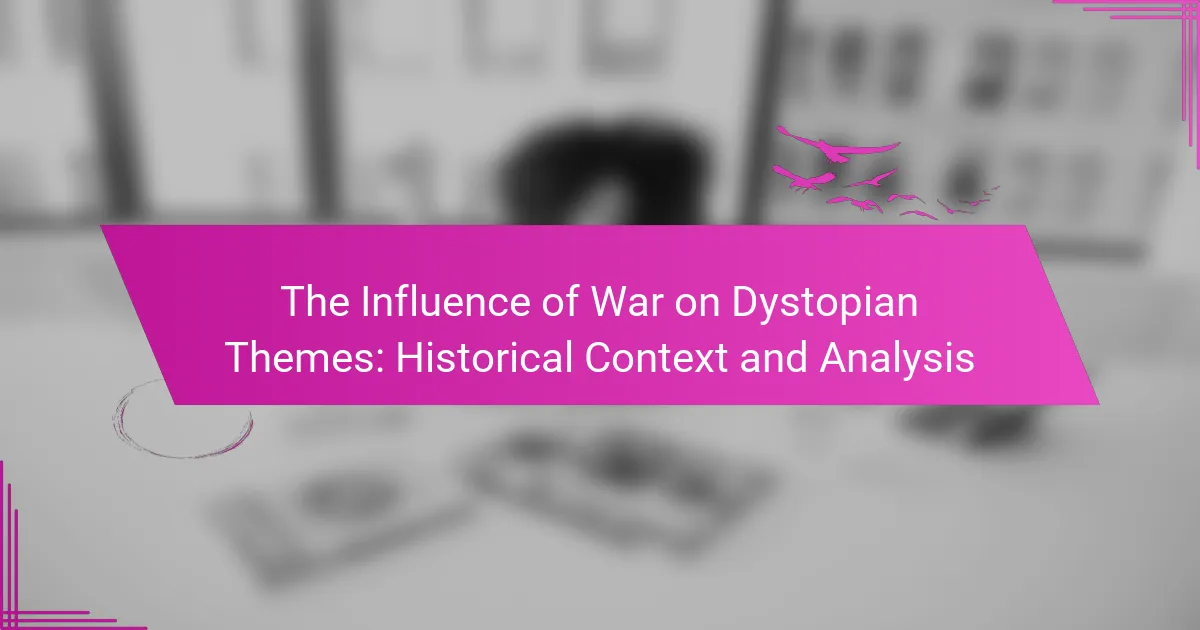War significantly influences dystopian themes in literature and film, reflecting societal collapse and moral decay. This article examines historical contexts, explores common traits in narratives, and analyzes cultural interpretations shaped by conflict. It also highlights unique attributes in specific works and discusses the psychological impacts of war on humanity. Through this analysis, we gain insights into the relationship between war and dystopian storytelling.
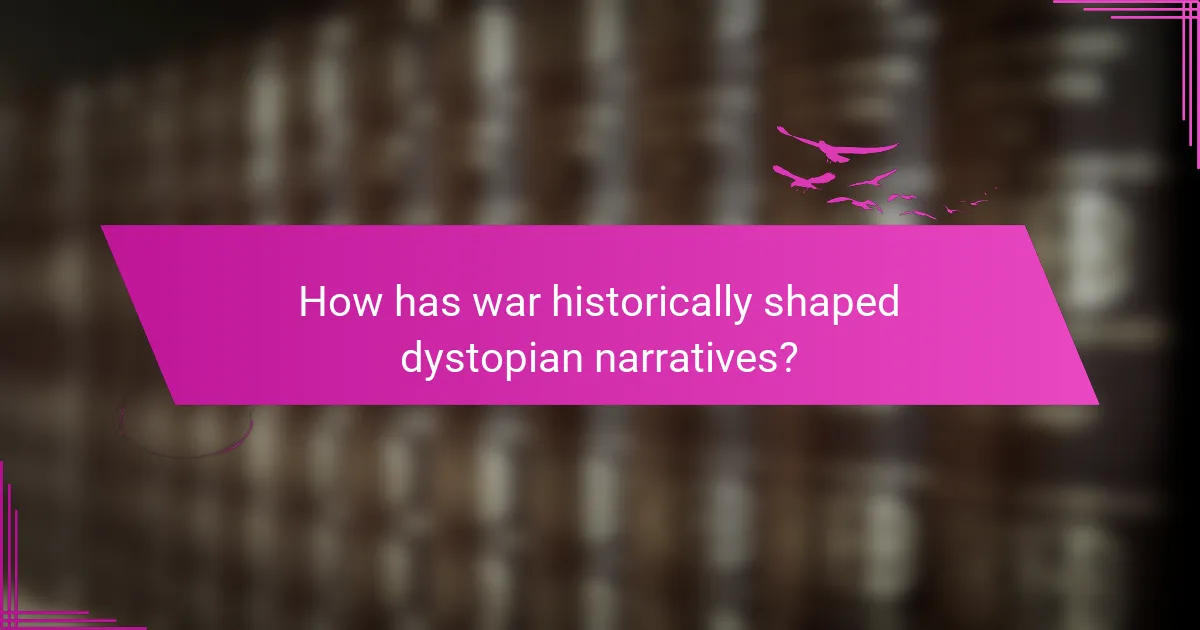
How has war historically shaped dystopian narratives?
War has profoundly shaped dystopian narratives throughout history by serving as a backdrop for societal collapse and moral decay. Major conflicts, such as World War I and II, have influenced literature and film, reflecting fears of totalitarianism and loss of individuality. For example, George Orwell’s “1984” emerged from the context of totalitarian regimes following the war, illustrating the dangers of oppressive governments. Additionally, the Cold War fostered themes of surveillance and paranoia in works like “Fahrenheit 451” by Ray Bradbury. These narratives often explore the consequences of war, including the erosion of trust and the fragility of civilization, showcasing the enduring impact of conflict on human experience.
What key events influenced dystopian literature and film?
War has profoundly shaped dystopian literature and film, reflecting societal fears and consequences. Major conflicts, such as World War I and II, influenced narratives by highlighting human suffering and totalitarian regimes. The Cold War era introduced themes of surveillance and paranoia, as seen in works like “1984.” Post-9/11 literature and film explored terrorism and loss of freedoms, emphasizing the impact of conflict on personal and societal levels. These historical contexts continue to resonate, shaping contemporary dystopian narratives.
Which authors and works reflect wartime themes?
Notable authors and works that reflect wartime themes include Erich Maria Remarque’s “All Quiet on the Western Front,” which captures the brutality of World War I. George Orwell’s “1984” explores the effects of totalitarianism, often linked to wartime propaganda. Kurt Vonnegut’s “Slaughterhouse-Five” addresses the impact of World War II through a unique narrative structure. Tim O’Brien’s “The Things They Carried” provides insight into the Vietnam War’s psychological toll. These works illustrate how war influences dystopian themes, shaping societal fears and moral dilemmas.
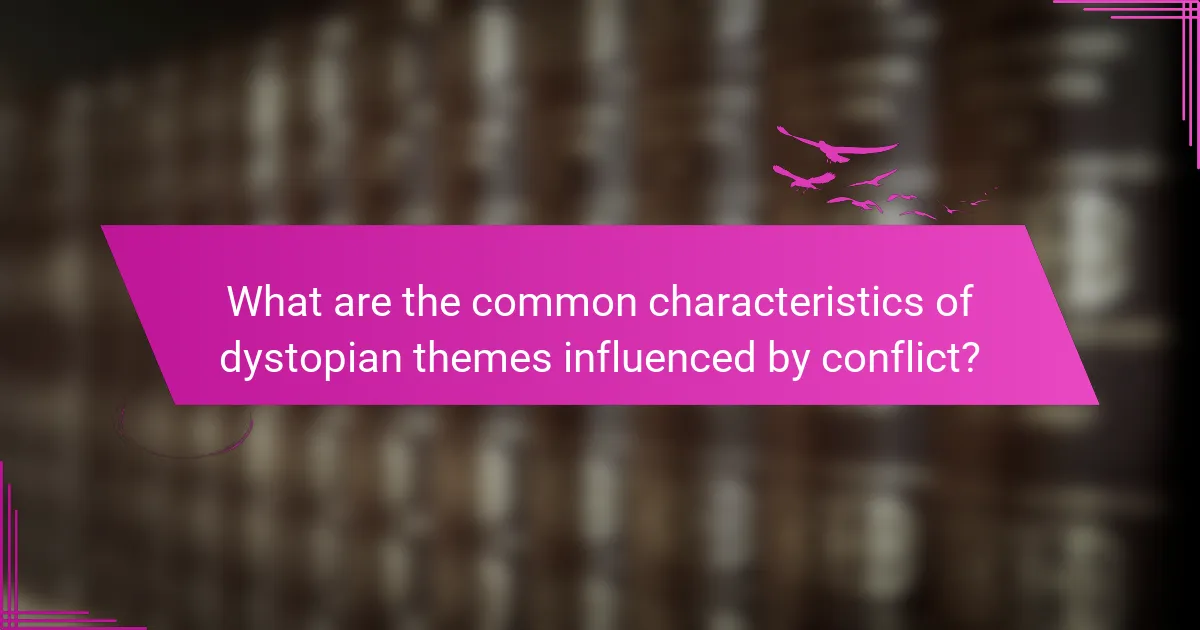
What are the common characteristics of dystopian themes influenced by conflict?
Dystopian themes influenced by conflict often share characteristics such as societal collapse, authoritarian governance, and pervasive surveillance. These elements reflect the psychological and social impacts of war on humanity.
Common traits include the exploration of moral ambiguity, where characters face difficult choices amid chaos. The portrayal of resource scarcity highlights the struggle for survival in war-torn environments. Additionally, themes of propaganda and misinformation illustrate how conflict shapes public perception and reality.
Conflict often leads to the dehumanization of individuals, showcasing the loss of empathy and the rise of brutality. These narratives serve as cautionary tales, warning against the consequences of unchecked power and societal division.
How do power dynamics manifest in war-themed dystopias?
Power dynamics in war-themed dystopias often reveal the struggle for control and survival. These narratives illustrate how authoritarian regimes exploit conflict to consolidate power, leading to societal oppression. For instance, in George Orwell’s “1984,” the Party manipulates war to maintain its dominance. Similarly, in “The Hunger Games,” the Capitol uses war as a tool for subjugation, showcasing a unique attribute of dystopian literature: the relationship between military conflict and social hierarchy. Through these examples, we see how power dynamics are not just a backdrop but a driving force in shaping the dystopian experience.
In what ways do societal collapse and survival emerge in these narratives?
Societal collapse and survival emerge in narratives as reflections of war’s destructive impact. These themes illustrate the fragility of civilization and the human instinct to endure amid chaos.
War often leads to resource scarcity, prompting communities to adapt or perish. Dystopian stories depict this struggle, highlighting unique survival strategies and the moral dilemmas faced by individuals.
The portrayal of societal collapse serves as a critique of real-world conflicts, emphasizing the consequences of violence on social structures. These narratives resonate with audiences, revealing underlying fears about humanity’s future.
In summary, the intersection of war and dystopia in literature underscores the complex relationship between societal breakdown and the resilience of the human spirit.
Which moral dilemmas are prevalent in war-related dystopian stories?
Moral dilemmas prevalent in war-related dystopian stories often revolve around survival, loyalty, and the ethics of violence. Characters frequently face choices that pit their personal morals against the harsh realities of war.
Survival often forces individuals to betray their values, leading to conflicts between self-preservation and ethical principles. Loyalty is tested as characters must choose between allegiance to comrades or to a greater cause, complicating their moral landscape.
The ethics of violence emerges as a critical theme, as characters grapple with the justification of their actions in the context of war. This dilemma highlights the tension between the necessity of violent actions for survival and the moral implications of such choices.
Overall, these dilemmas reflect broader societal questions about morality in extreme situations, emphasizing the psychological toll of war on individuals and communities.
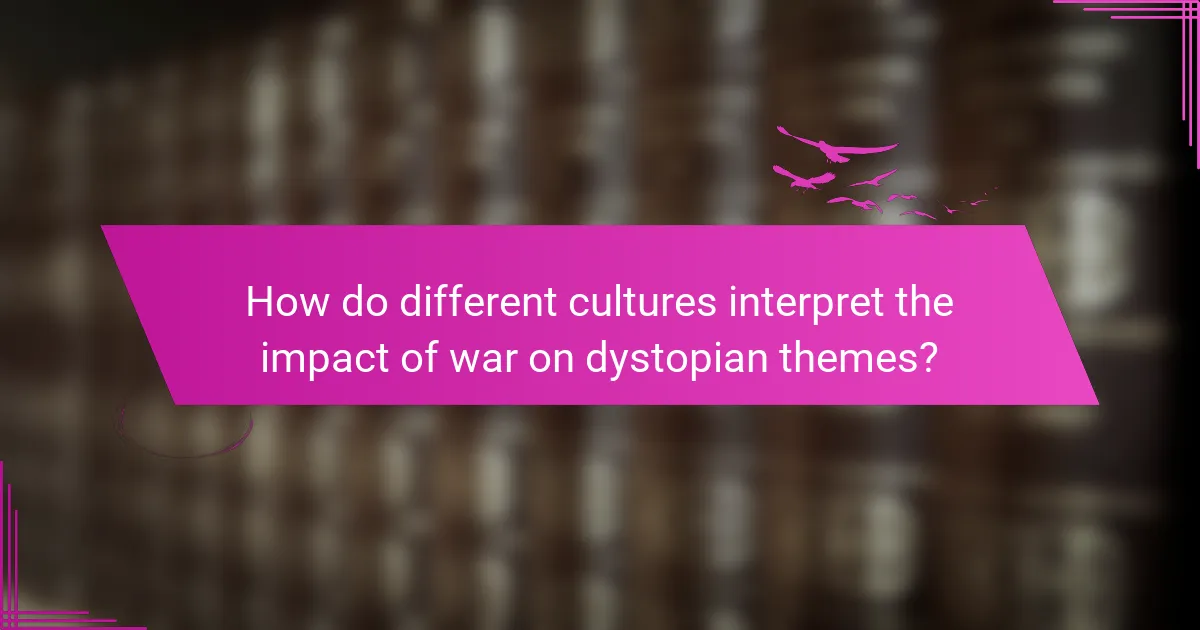
How do different cultures interpret the impact of war on dystopian themes?
Different cultures interpret the impact of war on dystopian themes through diverse lenses shaped by their historical experiences. Cultural narratives often reflect societal fears and aspirations influenced by the devastation of conflict.
For instance, in literature from post-war Europe, themes of loss and existential despair frequently emerge, showcasing the psychological scars left by war. In contrast, dystopian narratives from regions experiencing ongoing conflict may emphasize resilience and resistance, portraying war as a catalyst for social change.
Additionally, the portrayal of authority in dystopian works varies; cultures with authoritarian regimes often depict oppressive governments as a direct consequence of war. Conversely, societies with democratic foundations may explore themes of surveillance and loss of freedom in a post-war context.
Ultimately, the interpretation of war’s impact on dystopian themes reveals deep cultural insights, reflecting unique historical narratives and collective memories.
What regional variations exist in dystopian storytelling?
Regional variations in dystopian storytelling often reflect local historical conflicts and societal fears. For instance, Eastern European narratives frequently explore themes of totalitarianism, influenced by past regimes. In contrast, American dystopias may emphasize individualism and corporate control, stemming from capitalist critiques. Asian dystopian tales often incorporate technological surveillance, reflecting concerns over rapid modernization. Each region’s unique historical context shapes its storytelling, offering diverse perspectives on the human condition in dystopian settings.
How do cultural contexts influence the portrayal of war in dystopia?
Cultural contexts significantly shape how war is portrayed in dystopian narratives. Different societies interpret conflict based on their historical experiences, values, and social dynamics.
For instance, in post-colonial contexts, war may symbolize resistance against oppression, reflecting a unique attribute of cultural identity. In contrast, societies with a history of militarism may depict war as an inevitable aspect of life, emphasizing a root attribute of survival.
Additionally, the portrayal of technology in warfare varies; cultures with advanced technological backgrounds might present war through a lens of dystopian surveillance and control, while others may focus on the human cost and loss of community.
These perspectives influence themes of morality, power, and resilience, showcasing how cultural contexts enrich the narrative complexity of dystopian literature.
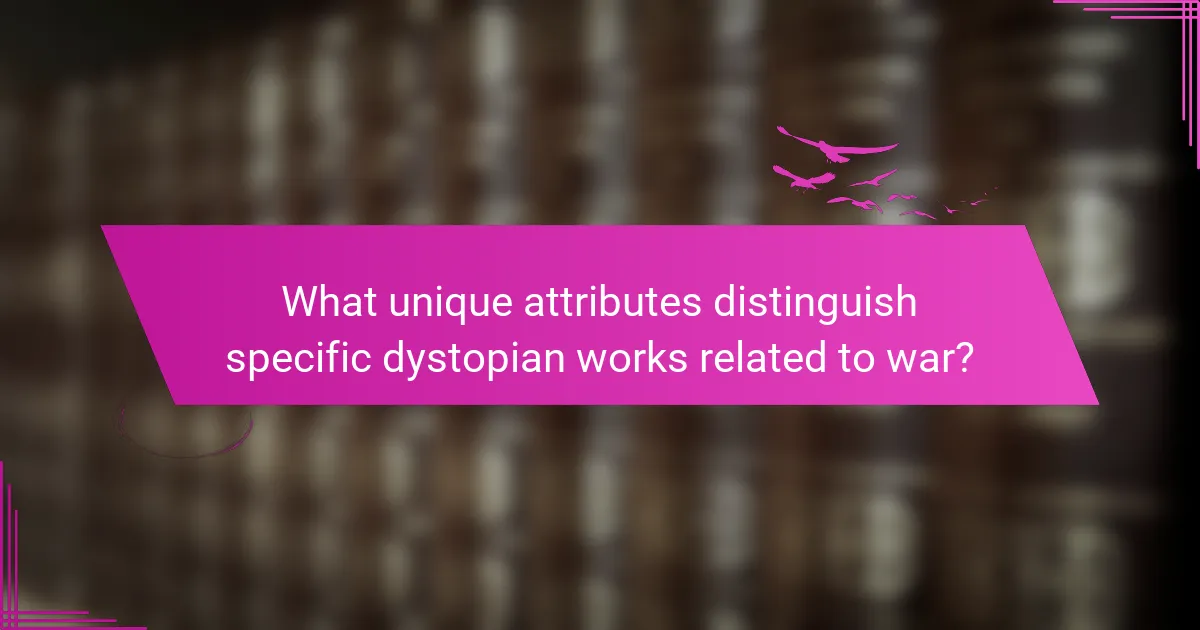
What unique attributes distinguish specific dystopian works related to war?
Unique attributes that distinguish specific dystopian works related to war include the portrayal of totalitarian regimes, the impact of technology on society, and the exploration of human resilience. Works like “1984” illustrate oppressive surveillance, while “The Road” showcases survival amidst devastation. Themes often reflect historical conflicts, emphasizing loss and moral ambiguity. These narratives uniquely capture the psychological effects of war, shaping character motivations and societal structures.
Which narratives offer innovative perspectives on warfare?
Innovative narratives on warfare often explore the psychological and societal impacts of conflict. Works like “1984” by George Orwell illustrate totalitarian regimes that arise from war’s aftermath. Similarly, “The Handmaid’s Tale” by Margaret Atwood examines the gendered consequences of societal collapse due to war. These narratives provide a lens to analyze how warfare shapes dystopian realities, emphasizing themes of oppression and survival. Such stories challenge conventional views of heroism and valor, presenting war as a catalyst for societal regression rather than progress.
How do character arcs differ in war-influenced dystopian settings?
Character arcs in war-influenced dystopian settings often emphasize transformation through trauma and survival. These arcs showcase characters evolving under extreme circumstances, reflecting moral ambiguity and the struggle for identity.
War amplifies themes of loss, betrayal, and resilience, leading to complex character developments. For example, protagonists may shift from innocence to hardened pragmatism, illustrating a unique attribute of war’s psychological impact.
In contrast, antagonists may embody rare traits, such as unyielding ambition or nihilism, driven by the chaos of war. This duality enriches narratives, highlighting the diverse responses to conflict.
Overall, war’s influence on character arcs creates a rich tapestry of human experience, revealing how extreme environments shape individuals.
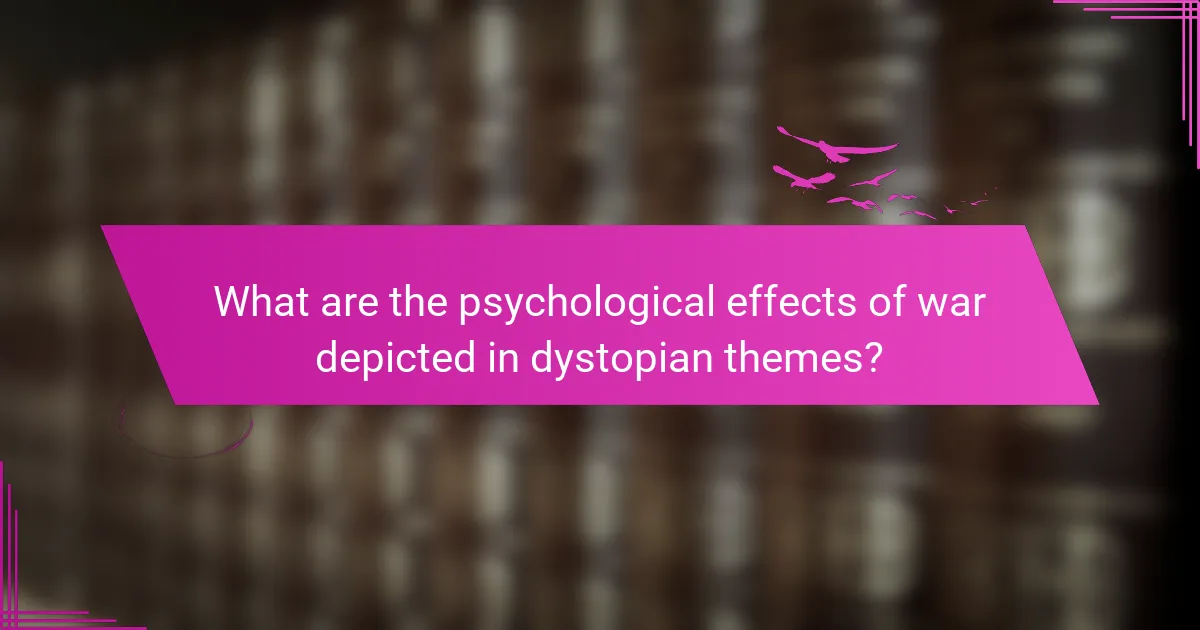
What are the psychological effects of war depicted in dystopian themes?
War profoundly influences dystopian themes, often depicting psychological trauma, societal collapse, and moral ambiguity. The psychological effects include pervasive fear, anxiety, and desensitization among survivors. Characters frequently grapple with post-traumatic stress, reflecting real-world consequences of conflict. Dystopian narratives illustrate the erosion of trust and the rise of authoritarianism, showcasing how war distorts human relationships and societal norms. As a result, these themes resonate deeply, offering critical insights into the human condition under duress.
How does trauma influence character development in these narratives?
Trauma significantly shapes character development in dystopian narratives, often driving transformation and resilience. Characters frequently emerge from war with altered perspectives, reflecting their struggles and the harsh realities of their environments. This transformation can manifest as heightened empathy, moral ambiguity, or a quest for redemption.
For instance, protagonists may become leaders who inspire hope or anti-heroes who navigate complex moral landscapes. The psychological scars of trauma often lead to deep-seated fears and motivations that propel characters’ actions. As a result, the interplay between trauma and character arcs enriches the narrative, allowing for a profound exploration of human resilience in the face of adversity.
Furthermore, the portrayal of trauma in these stories often serves as a critique of the societal structures that perpetuate conflict. Characters’ journeys highlight the consequences of war, emphasizing themes of loss, survival, and the quest for identity amidst chaos. This nuanced character development not only drives the plot but also engages readers in a reflective examination of the human condition.
Which coping mechanisms are portrayed in war-themed dystopias?
Coping mechanisms in war-themed dystopias often include escapism, resilience, and rebellion. Characters frequently resort to imagination or virtual realities to escape harsh realities. Resilience manifests through survival strategies and community support. Rebellion highlights resistance against oppressive regimes, showcasing human spirit amidst despair.
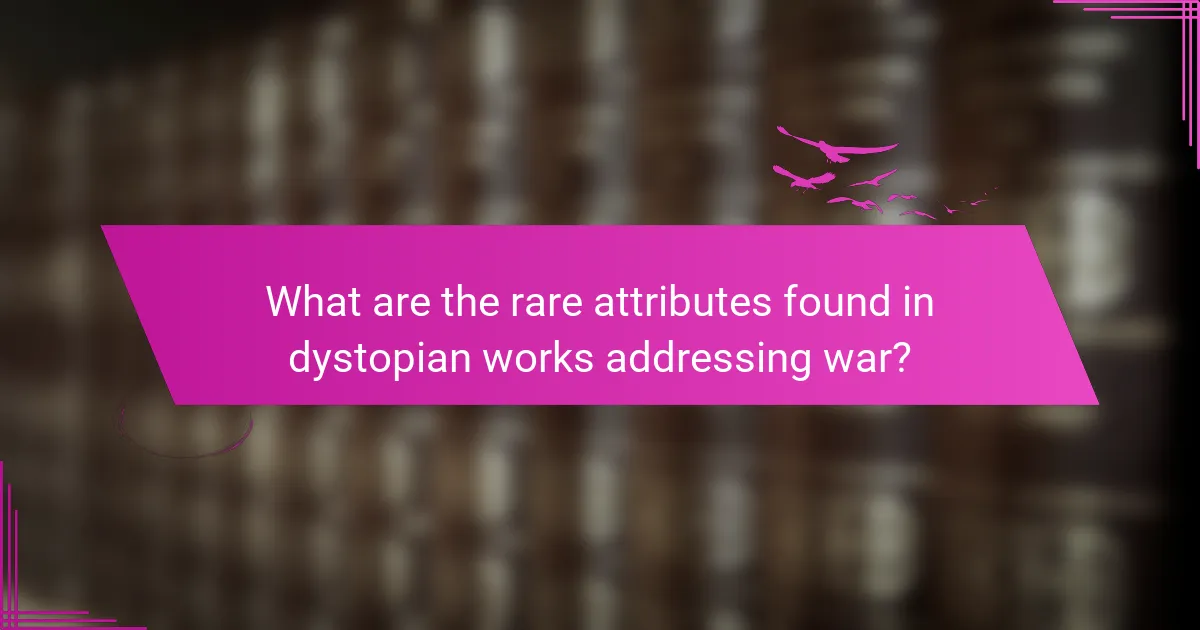
What are the rare attributes found in dystopian works addressing war?
Dystopian works addressing war often feature rare attributes such as extreme authoritarianism, post-apocalyptic settings, and the dehumanization of individuals. These elements highlight the psychological impact of war on society and the loss of personal agency. Additionally, they may explore themes of propaganda and the manipulation of truth, illustrating how war can distort reality. Such unique traits enhance the narrative depth and critique of societal issues.
How do experimental narrative structures enhance the war-dystopia connection?
Experimental narrative structures enhance the war-dystopia connection by creating immersive experiences that reflect the chaos of conflict. These structures often break traditional storytelling conventions, allowing for fragmented timelines and multiple perspectives. This mirrors the disorientation and trauma of war, deepening the emotional impact on the audience. As a result, narratives can explore themes of survival, loss, and societal collapse more effectively, resonating with historical contexts of dystopian literature. By challenging linear storytelling, these structures invite readers to engage critically with the implications of war on human existence and societal values.
What uncommon themes emerge in lesser-known dystopian stories about war?
Lesser-known dystopian stories about war often explore themes of isolation, moral ambiguity, and societal collapse. These narratives highlight the psychological impact of conflict on individuals and communities. For instance, characters may grapple with their humanity amidst dehumanizing circumstances. Additionally, the portrayal of technology in warfare reveals a unique attribute, emphasizing its role in shaping dystopian realities. Such stories frequently present rare perspectives, such as the experiences of marginalized groups, which are often overlooked in mainstream narratives.
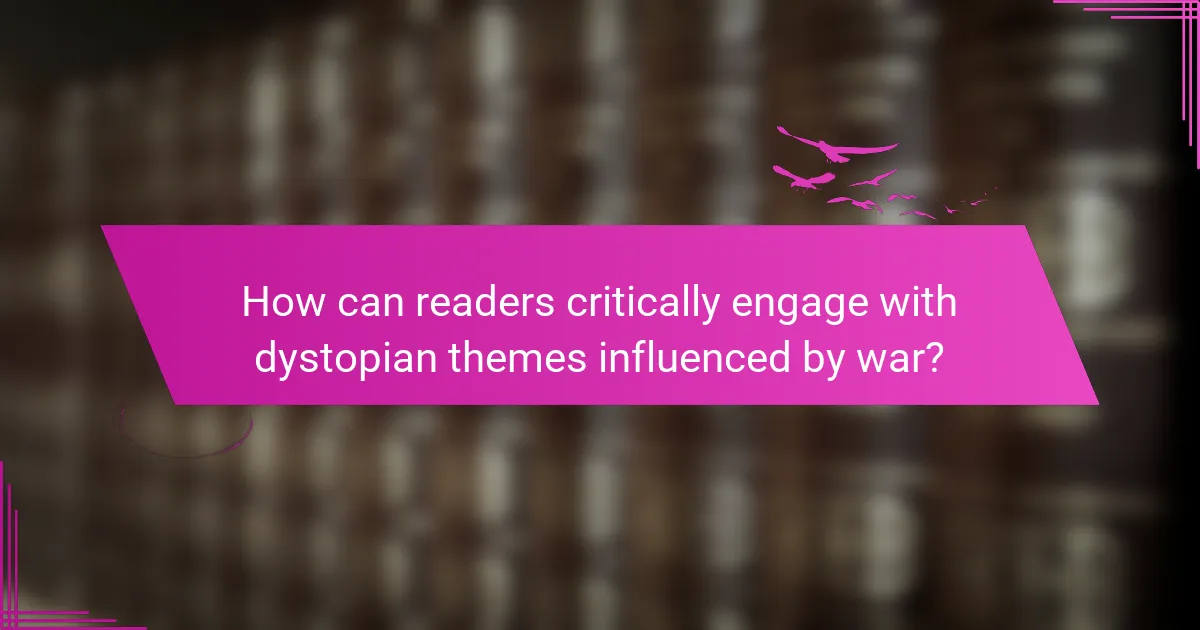
How can readers critically engage with dystopian themes influenced by war?
Readers can critically engage with dystopian themes influenced by war by analyzing historical contexts, character motivations, and societal implications. Examining how wars shape narratives reveals underlying critiques of power and morality. For instance, George Orwell’s “1984” reflects post-war anxieties about totalitarianism. Similarly, Margaret Atwood’s “The Handmaid’s Tale” critiques patriarchal structures exacerbated by conflict. Engaging with these texts encourages reflection on contemporary issues, fostering a deeper understanding of the cyclical nature of war and its impact on society.
What are best practices for analyzing war-related dystopian literature?
Analyzing war-related dystopian literature requires a focus on historical context, thematic development, and character motivations. Examine how wars shape societal structures and individual psyches in narratives. Identify recurring motifs such as loss, survival, and authoritarianism. Consider the unique attributes of specific works, exploring how their settings reflect real historical conflicts. Utilize comparative analysis to highlight differences in portrayal of war across various authors and time periods.
Which common mistakes should be avoided in interpreting these themes?
Avoiding common mistakes in interpreting the influence of war on dystopian themes is crucial for accurate analysis. Misinterpreting historical context can lead to skewed conclusions.
1. Overgeneralizing themes without considering specific historical events.
2. Ignoring the unique attributes of different wars and their societal impacts.
3. Failing to recognize how rare attributes shape dystopian narratives.
4. Neglecting the interplay between fictional representation and actual historical outcomes.
5. Relying solely on popular interpretations rather than engaging with primary sources.
